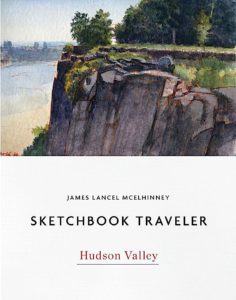Since March 8, 2020 Kathie Manthorne and I had been sequestered in our Washington Heights apartment. Like many New Yorkers and others around the world, we looked ahead to an uncertain future. Sirens wailed around the clock, as the sick and dying were removed from neighboring high-rises. Donning ad-hoc hazmat gear; double masked with nitrile gloves, our trips to the store were few. Beginning on April 1 2020, I published a series of quotidian blog-posts; words and artworks celebrating a personal engagement with history, nature and the environment. In relation to conventional painting, drawing, or word-smithing, I came to regard mindful exploration of our surroundings as an artistic practice in its own right. This is the second of these blogposts; rerun on the occasion of my migrating them from a queue on my website to a more permanent archive.

The North Gate, or Wind-Gate of the Hudson Highlands is formed by Storm King (Butter Hill) to the west (left) and Breakneck Mountain to the right, behind Bull Hill. In the middle distance is Little Stony Point. On the far shore is the city of Newburgh, where George Washington made his home and headquarters from May 1782 to August 1783. The tranquil cove just north of the landing, juxtaposed against the rugged majesty of these upward-thrusting hills, never fails to surprise and inspire.
One can easily imagine Hudson and his crew passing this place, wondering where the river might lead them. In the words of Robert Juet, writing on September 15, 1609,
“The morning was misty until the sunne arose: then it cleared. So wee weighed with the wind at South, and ran up the River twentie leagues, passing by High Mountaines. Wee had a very good depth . . . and great store of Salmon in the River”
–Robert Juet’s Journal, Voyage of Half Moon, September 15, 1609
Hudson did not know that at the same time Sieur Samuel de Champlain was exploring the lake that today bears his name and what is now Lake George. Had either party pressed on a little farther, they might have met near Glens Falls.

(An excerpt from SKETCHBOOK TRAVELER by James L. McElhinney (c) 2020. Schiffer Publishing).
